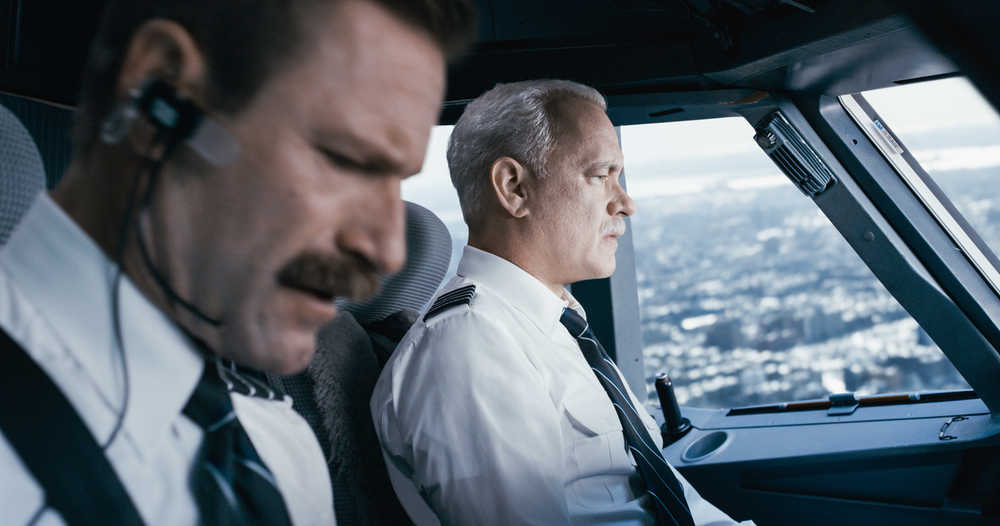“Sully”
Warner Bros.
1 hour, 36 minutes
“Sully,” Clint Eastwood’s latest, but hopefully not last, film is a mixed bag of triumphant successes and missed opportunities. It’s a perfect example of the strengths and weaknesses of the iconic director and his simple, pared down shooting style — quick, inexpensive yet still beautiful and stirring, yet wholly dependent on a competent script to shoot from.
“Sully,” which chronicles the heroic actions of US Airways pilot Chesley Sullenberger who, after flying into a flock of birds, managed to make a miraculous water landing on the Hudson River just minutes of leaving La Guardia airport in New York City.
“Sully” opens with a dramatic scene in the plane’s cockpit just prior to the dramatic water landing, as the pilots are attempting to determine what the best course of action would be. The scene plays out rather differently than you might remember, however, as the jumbo airliner plows directly into Midtown Manhattan disappearing in a massive fireball.
As Tom Hanks, as Captain Sullenberger, jerks awake with a gasp, the oft’ used cinematic device becomes obvious. In “Sully,” Clint Eastwood uses both dreams and flashbacks often, though not always with to the best effect. The morning after the crash, Captain Sullenberger and his copilot proceed to a hearing by the NTSB (National Transportation Safety Board), and an outcome automatically triggered by any airline mishap. Sully expects this much, though is surprised to find that the investigators do not share the public adoration for the captain, but instead are determined to find fault with this nearly impossible forced water landing.
As the film goes on we are treated to scenes of the accident played out from a different point of view, although unlike in the classic Japanese “Rashomon,” each point of view in “Sully” appears to be exactly the same. The film focuses on the NTSB proceedings relentlessly, though it’s unclear why the screenwriter felt this was the most important part of the story.
In truth, there are 155 more interesting stories to tell, and “Sully” only tells one of those, though it approaches a couple of others. The individual stories of the passengers that were saved — and Captain Sullenberger truly did not lose a single passenger in that crash — are so much more interesting and rewarding than the tale of a government safety board performing its due diligence.
One such story is that of three men, a father, son, and cousin, who just barely make the flight after having been delayed on a previous flight. In the melee after the crash, the father and son are separated and, even though I knew it would be all right, the terror that father feels is palpable. As is the joy at their reunion.
It’s amazing the emotional beats Clint is able to achieve, especially in a story whose main act contains only 208 seconds of action. The screenwriter should have dug deeper into those stories, making them comprise the flashbacks instead of bland, fairly pointless scenes from Sullenberger’s youth. It is truly remarkable that not a single person was killed, or even critically injured. I would have liked to have heard more about the people who lived.
Tom Hanks, as you might expect, does a masterful job in the roll of Sully. Aaron Eckhart, as copilot Jeff Skiles, is also fine, though his role is reduced to being the guy who is really angry at what the NTSB is doing to Sully. That’s a big part of what’s wrong with the film. The story doesn’t need a villain, but the script has one in the federal investigators. Why Eastwood and co. chose to spend so much time on this element of the story — crash investigations being a typically depressing but necessary aspect of modern aviation — is anybody’s guess.
Of all the performers, Laura Linney is the one that gets seriously short-changed. As Lorraine Sullenberger, Linney performs all her scenes from the same set, with the same prop — a phone. She is given nothing to do, no one to interact with, and doesn’t even get the satisfaction of a nice reunion with Hanks at the end. Her character is a serious misstep.
For as many things that don’t work about the movie, the scenes involving the actual crash are pretty amazing. Technically, no one can deny that Clint Eastwood is a top-notch filmmaker, and the film shows it. Quiet and thoughtful, at brief moments terrifying — there are parts of the film that work amazingly well. And, unlike most modern films, “Sully” is very short. The film clocks in at just over 90 minutes, and that’s only if you sit for all the credits. I’d say “Sully” is worth seeing for the good parts, and the parts that aren’t so good, well they’re over pretty quick.
Grade: B-
“Sully” is rated PG-13 for brief language and frightening scenes.
Chris Jenness is an art teacher, freelance graphic designer and artist who lives in Nikiski.

